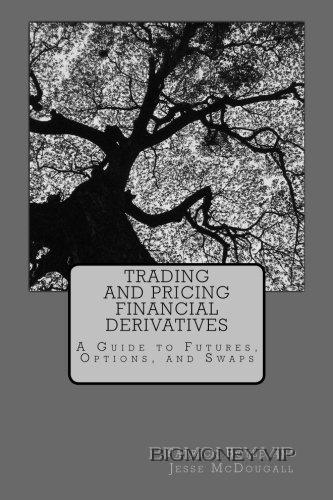Trading and Pricing Financial Derivatives: A Guide to Futures, Options, and Swaps by Patrick Boyle by Patrick Boyle

Chapter 1
Introduction to Derivatives
A financial derivative is an economic contract whose value depends on or is
derived from the value of another instrument or underlying asset. Derivatives are
categorized by the relationship between the underlying asset (the “underlying”)
and the derivative such as a forward, option, or swap1); the type of underlying
asset (such as equity derivatives, foreign exchange derivatives, interest rate deriv-
atives, commodity derivatives, or credit derivatives); the market in which they
trade (such as exchange-traded or over-the-counter); and their pay-off profiles.
Derivatives can be used for speculative purposes or to hedge. A speculator
is a trader who is taking positions with the goal of making a profit. A hedger is
a trader who already has an economic exposure who takes an offsetting posi-
tion (a hedge) in order to reduce a risk they already have exposure to. Very com-
monly, companies buy currency forwards (agreements to make trade a currency
exchanges at a future date) in order to limit (hedge against) losses due to fluc-
tuations in the exchange rate of two currencies, this is an example of hedging.
Third parties sometimes use publicly available derivative prices as educated pre-
dictions of uncertain future outcomes, for example, the likelihood that a corpora-
tion will default on its debts.
The Uses of Derivatives
Derivatives are used by investors for the following purposes:
– Hedging or mitigating risk in an underlying. By entering into a derivative con-
tract whose value moves in the opposite direction to their underlying posi-
tion, hedgers aim to reduce their risk.
– Speculate and make a profit if the value of the underlying asset moves the
way they expect.
– Obtain exposure to an underlying where it is not possible to trade in the
underlying (e.g., weather derivatives).
– Provide leverage, such that a small movement in the underlying value can
cause a large difference in the value of the derivative.
– Define their risk—traders can use options to give them quite defined risk
exposures, such as setting a maximum loss for a position.
– Tailored exposures—derivatives traders can take positions that profit if an
underlying moves in a given direction, stays in or out of a specified range, or
reaches a certain level.
Derivatives Underlyings
There are numerous underlyings for derivatives available right now, and new
ones are being developed every year.
– Equities of companies listed on public exchanges, such as General Electric,
Citigroup, or Vodaphone.
– Fixed income instruments, such as government bonds, corporate bonds,
credit spreads, or baskets of mortgages.
– Commodities, such as gold, oil, silver, cotton, or electricity.
– Indices, such as the FTSE 100, Hang Seng of Hong Kong, or Nikkei of Japan.
– Foreign exchange.
– Weather, such as the average temperature at a defined location or the amount
of rainfall.
– Events, such as football games or shipping catastrophes.
Derivatives Market Participants
Hedgers
Hedgers are often producers or consumers of an underlying. They can be compa-
nies that are required to typically have exposure to particular underlying in the
normal running of their businesses. Derivatives allow risk related to the price of
the underlying asset to be transferred from one party to another. For example,
a corn farmer and a cereal manufacturing company like Kellogg’s could sign a
futures contract to exchange a specified amount of cash for a specified amount of
corn in the future. Both parties have reduced a future risk, and thus are hedgers.
Both parties reduce their exposure to sudden variations in the price of corn which
could materially affect their respective businesses.
Another example would be if a corporation borrows a large sum of money at
a specific interest rate and that interest rate resets every six months. The corpo-
ration is concerned that the rate of interest may be much higher in six months.
The corporation could buy a derivative called a forward rate agreement (FRA),
which is a contract to pay a fixed rate of interest six months after purchase on a
pre-agreed upon notional amount of money. If the interest rate after six months




